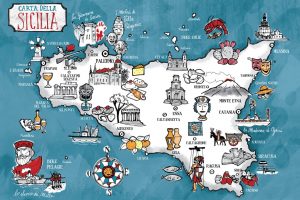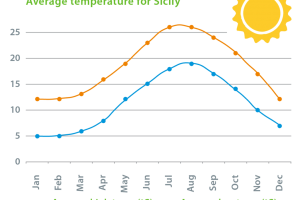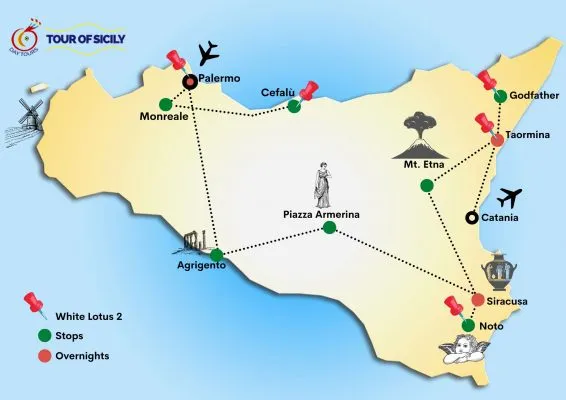8 Days in Sicily

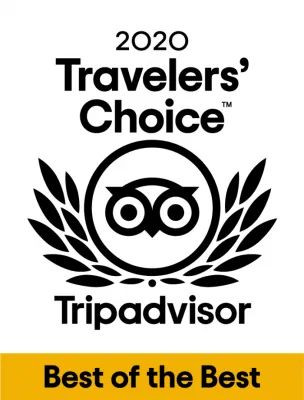
Personalized Trips to Sicily
Let me introduce you the 8 day-tour which is a good way to explore the most important local highlights of Sicily. We have shown three different solutions which involve the west, the east, the south and the south-east.
Feel free to verify which is the one that fit your needs and expectations and in case you wish us to customize your tour feel free to share with us your needs.
Sicily at a glance
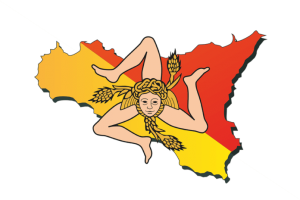 Sicily, the largest island in the Mediterranean, is a captivating blend of ancient architecture, beautiful, hidden away beaches and a bustling capital full of charisma and authentic charm.
Sicily, the largest island in the Mediterranean, is a captivating blend of ancient architecture, beautiful, hidden away beaches and a bustling capital full of charisma and authentic charm.
Thanks to its geographical location, Sicily has had the major role in the historical events that have played a key role in the Mediterranean.
The not-to-be-missed cities of Sicily
Palermo. Palermo bears witness to its past—conquered by the Phoenicians, Arabs, and Spanish, its churches and archeological remnants are unrivaled. Then the Palazzo dei Normanni and its Byzantine mosaics never fail to awe visitors; Normal Royal Palace and Palatine Chapel are divine; golden beaches of Mondello Lido, the foodie delights of the city’s markets, the Botanical Gardens—all are must-see sights in Palermo.
Monreale. The city’s Duomo is one of the greatest medieval treasures in the world—the 58,000 square feet of mosaics will take your breath away.
Siracusa and Ortygia Island. Archimedes, Cicero, Saint Paul, Caravaggio, and the naval hero Lord Admiral Horatio Nelson all made their presence known in Siracusa. In fact, Aeschylus premiered his plays at the still-functioning Teatro Greco here. One of the most beautiful squares in Italy, the Piazza del Duomo, is in the tiny island of Ortygia
Taormina. Perhaps there is no more famous name in Sicily than Taormina. This resort town draws the international jet set to its romantic alleys and glittering hotels. But Taormina is steeped in ancient history and mythology—Giardini-Naxos, Teatro Greco, and the Norman and Baroque monuments are all worth a visit.
Of course, Mt. Etna, Europe’s highest volcano, is in Taormina, and no visit to Sicily would be complete without gazing at its stunning vistas.
Mt Etna, locally called “Mongibello”, is Europe’s largest and most active volcano. Its frequent eruptions are often accompanied by large lava flows, but rarely pose danger to inhabited areas. Etna is one of the volcanoes with the longest historic records of eruptions, going back more than 2000 years. Read More
Marsala. The city is more than the sweet wines which bear its name and for which the city is famous (but don’t miss the historic Florio Winery and the Donnafugata Winery). You’ll also want to see Marsala’s salt marshes—and be sure to try busiati, the oldest handmade pasta in the world. Read More
Trapani. Ornate churches like the Cattedrale di San Lorenzo and the Torre della Colombaia define the architecture here. Don’t miss shopping for the city’s famous exquisite coral jewelry.
Ragusa. Ragusa Ibla is a fairytale of church domes and terracotta roofs. The Duomo di San Giorgio, the Giardino Ibleo, and the 18 listed UNESCO monuments will delight you.
Agrigento. The city’s greatest draw is the Valley of the Temples and its ancient Greek ruins. Tempio della Concordia is one of the best-preserved temples in the world. You’ll definitely want to visit the Museo Regionale Archeologico, perhaps the best museum in Sicily, which features the famous stone statue of Telemon (Atlas).
Catania. In a perfect world, you’d devote two full days to the art, museums, and Roman ruins of Catania. Don’t miss Duomo Square, La Pescheria (the fish market), and the Bellini Gardens.
Erice. This western Sicily gem is famous for its almond biscuits (the pastry shops here are without equal). Erice’s main church and bell tower are striking, as is the Norman castle, also known as Venus Castle, a tribute to the goddess of fertility.
Or what about Sicily’s unique cuisine—Arab and Greek spices, Spanish techniques, the world’s finest seafood. And it’s all accompanied by big, fruity, out-of-this-world wines.
Sicilian food is also considered the original fusion cuisine, a unique mix of all of its diverse cultural heritages.
The island has been at the heart of thirteen different empires over the last three millennia, and each one of them has left its mark on the Sicilian Gastronomy.
Must-try Local Dishes and Wines
Pasta alla Norma – pasta served with a special sauce made of tomatoes and fried eggplant with ricotta cheese
Arancine – fried rice balls coated with breadcrumbs and often filled with cheese or ragù sauce
Cannoli – a tube shaped pastry that is stuffed with a sweet, creamy filling often made from ricotta cheese. Read More
Caponata – a typical antipasto that you’ll encounter in every corner of Sicily; a delicious sweet and sour (agrodolce) mixture of fried eggplant, onions, celery, tomatoes, vinegar, capers, and olives, sweetened with a bit of sugar. Read More
Almond Cookies – a famous local dessert typical of Sicily. Soft and tasty, they are fast to make (and to eat…). They are also a gluten-free dessert. Read the recipe
The Chocolate in Modica – made with a very old recipe, the one coming from the Aztecs. Read More
The Predominant Grapes – Historically, Italian wine regions have clung tightly to its historical grapes, and Sicily is no different. While international varieties are prominent players, for critics, sommeliers, and importers, the wines they dream about at night are indigenous. There are three key red grapes: Nero d’Avola, Frappato and Nerello Mascalese.
Information
Travel Tips
If it is your first time to Sicily, get ready for an incredible experience!
The prospect of visiting Sicily for the first time will provoke a wide range of emotions. For some, traveling to a foreign land-especially one that doesn’t speak English – is so intimidating that any real enjoyment can only be realized with the help of a native to navigate through all the unfamiliar turf. For others, even those who don’t speak Italian, the opportunity to be immersed in an entirely new culture is part of the fun, and they look forward to feeling their way through each of the novelties that Italy throws at them.
Tipping
- Taxis: Government-regulated taxis are either white or yellow. Avoid taxis that are not metered and have no official signs. They are private cars that will charge you an expensive fee. Unlike in the U.S. where taxis are hailed on the street, in Sicily they are found at taxi stands or are called by telephone. All charges are listed on a price chart displayed inside the cab. Extra charges are in effect at night, for luggage service and phone booking. A 10% tip is expected but not mandatory.
- Restaurant tipping: Both il servizio (service charge/tip) and il coperto (cover charge for bread and water) are usually included in il conto (the bill). By Sicilian law the gratuity is included in the bill so extra tipping isn’t required. However, it is customary, especially if the service is good, to leave an additional gratuity between 5% and 10%.
- Hotel Tipping: Tipping in hotels is a customary practice. The service charge of 15% – 19% is already included in your bill. Other suggested tips include 50 euro cents per day to the chambermaid, 50 euro cents to the doorman for calling you a cab, and between 1 and 2 euros for the bellhop if he carries your bags to your room. The concierge expects about a 15% tip on his or her bill, as well as tips for any extra services. If you are staying at a 4- or 5-Star hotel these suggested amounts should be doubled.
Useful Knowledge:
- Shopping: Italian stores generally are open from 9 a.m. to 1 p.m. The siesta/pausa lunch break lasts until 4 p.m. Stores close for the day by 8 p.m. Most stores are closed on Sunday.
- Café Culture: While enjoying an espresso at a table is always possible, the locals enjoy standing at the banco, or bar area.
- Hand Gestures and Loud Voices: Unlike in the U.S. of A., hand gestures and loud voices can be a way of expressing profound happiness.
Hotel Information:
- Hotels: When looking for a place to stay, remember that rates include taxes and service; the IVA (value-added tax, currently 10%) should be added to the total amount.
- Electrical: Not all hotel rooms provide hairdryers; if you bring your own, an adapter/transformer is a necessity. This will also be important for all other electrical devices, including laptop computers, because in Italy the voltage is different (220). Also, outlets have two round-pronged plugs, which is another reason an adapter plug is necessary.
Just the Basics:
- Sicily’s Time Zone: one hour ahead of Greenwich Mean Time (GMT+1). Sicily is generally six hours ahead of Eastern Standard Time in the United States, aside from the rare instances affected by the Spring Forward/Fall Back clock-changing discrepancy when the difference is five hours.
- Country Code (for international calls to Italy): +39.
- Currency: Euro. Available in bills of 5, 10, 20, 50, 100, 200, and 500 euros; coins of 1 and 2 euros and 1, 2, 5, 10, 20, and 50 euro cents.
- Official Language: Italian and Sicilian
- Flag: The Italian tricolor is green, white, and red, in three vertical bands, equal in dimension. The Sicilian flag shows a triskeles symbol (a figure of three legs arranged in rotational symmetry), and at its centre a Gorgoneion (depiction of the head of Medusa) and a pair of wings and three wheat ears.
- Religion: Roman Catholic is the main faith – 85% of native-born citizens are nominally Catholic. There are substantial Protestant, Jewish, and Muslim communities.
- Education: Sicily has statewide education system, with a five-year primary stage and an eight-year secondary stage.
Currency
Like other member countries of the European Union, Sicily uses the euro, symbolized by “€”. For the current conversion rate between your currency and the euro you can check a currency exchange Web site such as www.xe.com
ATM Cash Machines (bancomats) are everywhere in Sicily as they are in the United States. The Cirrus and Plus systems are the most widely available. Be aware that many Sicilian cash machines will not accept card with PIN codes, five numbers or longer so be sure to reset your PIN to a four numbers before you go. You may also have a problem accessing a savings account so be sure the ATM card(s) you are bringing are linked to checking accounts. You may also be able to use your credit card for a cash advance if it has a PIN code (fees will apply).
Many travelers wonder about bringing travelers checks with them and it simply isn’t a good idea anymore. You’ll pay a fee for the checks at home, will need to find a bank (banks are usually open for a few hours in the morning and a few hours in the afternoon on week days) when it is open, wait in line and pay another service fee when receiving euros.
Credit cards are widely accepted throughout Sicily. Visa and MasterCard are more commonly accepted so if you’re bringing an American Express card, be sure to bring a Visa/MasterCard as well. Many credit card companies (Capitol One is an exception) are now charging a transaction fees for international purchases. Be sure to check with your credit card company before leaving home. Finally, cash is king in Sicily. Sicilian merchants hate paying service fees on credit card transactions and will often give you a discount (sconto) for paying cash. Of course, they also like to hide their earning from the tax authorities too, but that’s a whole other story.
Shopkeepers are also open to giving discounts if you are buying multiple items. Don’t be afraid to ask for a sconto!
City Taxes
When staying overnight in Sicily, certain cities have a tourist tax.
This Sicily City tax must be paid by the PASSENGER directly to the hotel before the end of the stay.
| City | 5 star | 4 star | 3 star | |
| Palermo | eur 3 | eur 2 | eur 1.50 | |
| Catania | eur 2.50 | eur 1.50 | eur 1.50 | |
| Taormina | eur 5 | eur 3.50 | eur 2 | |
| Syracusa | eur 2.50 | eur 2 | eur 1.50 | |
| Agrigento | eur 3 | eur 2 | eur 2 | |
| Trapani | eur 3 | eur 2.50 | eur 2 | |
| Ragusa | eur 2.50 | eur 1.50 | eur 1 | |
| Cefalù | eur 3 | eur 2 | eur 1.50 | |
| Messina | eur 4 | eur 2 | eur 1.50 |
Internet
Wireless access is prevalent in restaurants and hotels and most hotels no longer charge for you to use WiFi.
You can access it with your phone or laptop computer.
If you choose not to bring a device with you, most hotels make a desktop computer available for guests to use or have a business center available.
Sicily airports
There are four airports in Sicily, two serving the east coast (Catania and Comiso airports) and the other two (Palermo and Trapani airports) – the west coast.
Palermo Falcone & Borsellino (PMO) and Catania Fontanarossa (CTA) are the biggest airports operating actively all the year round. Both become very busy in summer months.
Trapani Birgi (TPS) and especially Comiso Pio La Torre airport mostly serve low-cost airlines and seasonal flights.
Air, sea or land?
There are ways to get to Sicily from mainland Italy or from Malta without flying.
These include long-distance buses from other regions in central (mainly Rome) and southern Italy, trains or ferries.
However, flying to one of the Sicily airports is probably the fastest, and arguably the most convenient way to arrive at your final destination.
Busy itinerary? Fly anywhere!
If you are planning to explore the island and change your location at least two or three times it does not make much difference which airport to arrive.
You can even consider to arrive at one airport and depart from the other.
This is usually convenient and optimizes timing in case you want to move around and see more. Typically Palermo and Catania would be the preferred options.
Having a clear idea of what kind of a vacation you are planning to have, and what is your itinerary will make the choice of the airports easier. It is also possible to build an itinerary around your arrival and departure points, especially if your plans are not overwhelming.
Still, east or west – what is best?
Roughly speaking, Palermo airport is an optimal arrival point to reach destinations along the west coast between San Vito lo Capo and Cefalu. Corleone and the Madonie mountains would be on the same list, just a bit away from the coastline. Trapani airport is closer than any other one to Castellammare del Golfo, the Egadi islands including Favignana, Marsala, Erice, Segesta, Mazzara del Valo and Selinunte. The southern coast from Agrigento to Trapani itself is also within easy reach.
Catania airport serves best final destinations like Taormina, the Aeolian islands, Messina, Giardini Naxos, Acireale its coast, Etna, Siracuse and Noto, Caltanissetta. Comiso is optimal for Ragusa, Scicli, Modica and Licata, while Piazza Armerina and Caltagirone are similar travel distance from both Catania and Comiso airports. Agrigento, Tindari and Enna are equally convenient from Catania and Palermo airports with Agrigento and Tindari taking some 2 -2,5h drive. These are probably the farthest among popular locations on mainland Sicily. Agrigento is similar 2 – 2.5 h drive distance from Trapani and Comiso as well.
Visiting Sicily: days, weeks, and beyond
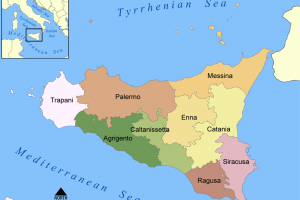 Sicily is an island and has 9 provinces (Palermo, Agrigento, Caltanissetta, Catania, Enna, Messina, Ragusa, Siracusa, Trapani), each with its own identity.
Sicily is an island and has 9 provinces (Palermo, Agrigento, Caltanissetta, Catania, Enna, Messina, Ragusa, Siracusa, Trapani), each with its own identity.
Landscapes, cuisine, and dialect differ greatly from one to the next, and each merits its own visit.
If your time is limited, you’ll be able to see Sicily’s highlights in a matter of days—but spending one week or more means you’ll get to explore multiple provinces and fall in love with the authentic Sicily.
If you have a few days in Sicily, it’s best to focus on one city, otherwise you’ll likely feel like you’re spreading yourself too thin!
In three or four days lodge in one city only and from here explore and enjoy the area.
The most important cities are Palermo — located on the west side — Taormina and Syracusa — both located on the east –.
In one week, you’ll be able to explore Sicily’s wonderful cultural cities, undoubtedly a highlight of any trip to the country. Palermo, Agrigento, Taormina and Syracusa attract the bulk of tourists and justifiably so—they harbor some of the world’s most impressive architecture and works of art.
Nine days will give you more time to explore what Sicily offers beyond the usual tourist destinations. You’ll be able to travel along the stunning Marsala, Erice, Ragusa, Modica and Noto, which offer some of Europe’s most enchanting scenery.
However, to experience Sicily at its best, you’ll need to factor in two weeks. That way, you’ll have enough time to discover a large part of the island and one (or perhaps both!) of its major islands, Lipari and Vulcano.
Interesting facts
 Treat yourself with the amazing Original Cannoli, a Sicilian speciality made of crispy dough and a creamy ricotta cheese filling.
Treat yourself with the amazing Original Cannoli, a Sicilian speciality made of crispy dough and a creamy ricotta cheese filling.
A dessert now known and appreciated all over the world, a pillar of “Sicilian Culture“. We can safely say that visiting Sicily without eating cannoli is like not having visited it at all.
For those who do not know it (We doubt there is someone who does not know what we are talking about) the Sicilian cannoli is a dessert consisting of a crunchy fried wafer in lard, called “scorza (rind)“, filled with sheep’s ricotta cream with a sprinkling of chocolate or pistachio and candied fruit at both ends.
Explore Sicily in 8 days
On this eight-day itinerary, you’ll uncover layers of history in the island of Sicily.
Some travelers pass through for a day or two on their way to other destinations, but eight days is an ideal amount of time to get a feel for the Palermo, Agrigento, Syracusa and surroundings.
Day
Day 1
Day 2
Day 3
Day 4
Day 5
Day 6
Day 7
Day 8
Highlights
Arrival in Palermo
Palermo Highlights
Cefalù and Monreale
Segesta and Selinunte
Agrigento Highlights
Piazza Armerina and Caltagirone
Syracusa Highlights
Goodbye Syracusa!
Overnight
Palermo
Palermo
Palermo
Agrigento
Agrigento
Syracusa
Syracusa
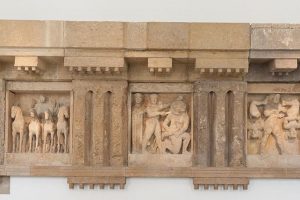 The eight-day-trip begins in the historic center with a lovely walking tour to explore Palermo. Our first stop is at the Palatine Chapel, a finest example of Arab-Norman art. Built by Roger II from 1130 to 1140, the chapel is adorned with extraordinary Norman-Byzantine mosaics. We then continue onto the Four Corners which is the junction in Palermo. You will almost inevitably pass through it and it is worth stopping for five minutes to have a look at its sculptures which were commissioned by the Spanish Viceroy in 1611. The sculptures on each of the four corners depict a variety of themes, including the four seasons, four Spanish kings and the four patron saints of the old town areas. Going south-east down Via Maqueda you will come across Piazza Pretoria which is home not only to a splendid fountain but several other impressive buildings including, on the right, the City Hall. The fountain, known for generations as the “Fountain of Shame”, has an interesting history. The large central fountain is the focal point for sixteen nude statues of nymphs, humans, mermaids and satyrs. If you imagine this being erected during the Inquisition, it is quite easy to imagine why it received its epithet, the “Fountain of Shame”. The last but not the least is our stop is at the Archaeological Museum. Situated in a Renaissance monastery, this splendid museum houses some of Sicily’s most valuable Greek and Roman artefacts, including the museum’s crown jewel: a series of original decorative friezes from the temples at Selinunte. Other important finds in the museum’s collection include Phoenician sarcophagi from the 5th century BC, Greek carvings from Himera, the Hellenistic Ariete di bronzo di Siracusa (Bronze Ram of Syracuse), Etruscan mirrors and the largest collection of ancient anchors in the world.
The eight-day-trip begins in the historic center with a lovely walking tour to explore Palermo. Our first stop is at the Palatine Chapel, a finest example of Arab-Norman art. Built by Roger II from 1130 to 1140, the chapel is adorned with extraordinary Norman-Byzantine mosaics. We then continue onto the Four Corners which is the junction in Palermo. You will almost inevitably pass through it and it is worth stopping for five minutes to have a look at its sculptures which were commissioned by the Spanish Viceroy in 1611. The sculptures on each of the four corners depict a variety of themes, including the four seasons, four Spanish kings and the four patron saints of the old town areas. Going south-east down Via Maqueda you will come across Piazza Pretoria which is home not only to a splendid fountain but several other impressive buildings including, on the right, the City Hall. The fountain, known for generations as the “Fountain of Shame”, has an interesting history. The large central fountain is the focal point for sixteen nude statues of nymphs, humans, mermaids and satyrs. If you imagine this being erected during the Inquisition, it is quite easy to imagine why it received its epithet, the “Fountain of Shame”. The last but not the least is our stop is at the Archaeological Museum. Situated in a Renaissance monastery, this splendid museum houses some of Sicily’s most valuable Greek and Roman artefacts, including the museum’s crown jewel: a series of original decorative friezes from the temples at Selinunte. Other important finds in the museum’s collection include Phoenician sarcophagi from the 5th century BC, Greek carvings from Himera, the Hellenistic Ariete di bronzo di Siracusa (Bronze Ram of Syracuse), Etruscan mirrors and the largest collection of ancient anchors in the world.
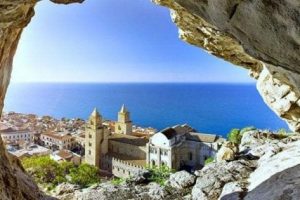 On the thirth days we join the lovely village of Cefalù. While Cefalù’s origins go back to at least Greek times, the town we now know and love was built at the behest of the Norman King, Roger II. Construction of the Cathedral began in 1131 and is an exquisite example of what has been termed “Sicilian Romanesque”. Thanks to the splendid mosaic of Christ Pantocrator above the altar, it is twinned with the Palatine Chapel in Palermo and the Dome in Monreale. Exploring the town we will join the Lavatory, which is fed by a natural spring and the Osterio Magno which, according to tradition was King Roger’s very own residence. This afternoon, on the way back to Palermo, we will stop in Monreale to see where Arab-Norman art and architecture reached its pinnacle in the Duomo, launched in 1174 by William II. It represents scenes from the Old and New Testaments all in golden mosaics. Learn More
On the thirth days we join the lovely village of Cefalù. While Cefalù’s origins go back to at least Greek times, the town we now know and love was built at the behest of the Norman King, Roger II. Construction of the Cathedral began in 1131 and is an exquisite example of what has been termed “Sicilian Romanesque”. Thanks to the splendid mosaic of Christ Pantocrator above the altar, it is twinned with the Palatine Chapel in Palermo and the Dome in Monreale. Exploring the town we will join the Lavatory, which is fed by a natural spring and the Osterio Magno which, according to tradition was King Roger’s very own residence. This afternoon, on the way back to Palermo, we will stop in Monreale to see where Arab-Norman art and architecture reached its pinnacle in the Duomo, launched in 1174 by William II. It represents scenes from the Old and New Testaments all in golden mosaics. Learn More
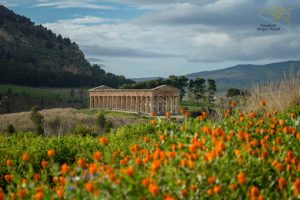 Your fourth day is dedicated to the visit of Segesta and Selinunte on the way to join Agrigento. Your firth stop is onto Segesta, one of the major cities of the ancient indigenous Elymian people, to visit the impressive Doric temple. Dated back to the 5th century BC, this ancient Greek temple can make a valid claim to being the best preserved in the world, though never completed as the roof was never added. Later this afternoon we drive to Selinunte, the largest Archaeological Park in Europe, an the only lovely located, sitting on a high plain and overlooking the sea. It is flanked on either side by golden beaches and, being almost 1km wide, is an excellent excuse for a good walk, though it is also possible to get around. Finally onto Agrigento.
Your fourth day is dedicated to the visit of Segesta and Selinunte on the way to join Agrigento. Your firth stop is onto Segesta, one of the major cities of the ancient indigenous Elymian people, to visit the impressive Doric temple. Dated back to the 5th century BC, this ancient Greek temple can make a valid claim to being the best preserved in the world, though never completed as the roof was never added. Later this afternoon we drive to Selinunte, the largest Archaeological Park in Europe, an the only lovely located, sitting on a high plain and overlooking the sea. It is flanked on either side by golden beaches and, being almost 1km wide, is an excellent excuse for a good walk, though it is also possible to get around. Finally onto Agrigento.
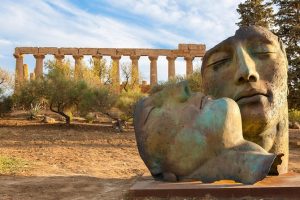 On your fifth day enjoy Agrigento and the finest of all ancient Greek sites—the complete Doric Temples, one of the most outstanding examples of Greater Greece art and architecture, and is one of the main attractions of Sicily as well as a national monument of Italy. The Valley of the Temples is certainly the most important testimony of the ancient, classical culture of Sicily. It brings together the temples of gods goddesses as well as the area of the necropolis and sanctuaries outside the walls.
On your fifth day enjoy Agrigento and the finest of all ancient Greek sites—the complete Doric Temples, one of the most outstanding examples of Greater Greece art and architecture, and is one of the main attractions of Sicily as well as a national monument of Italy. The Valley of the Temples is certainly the most important testimony of the ancient, classical culture of Sicily. It brings together the temples of gods goddesses as well as the area of the necropolis and sanctuaries outside the walls.
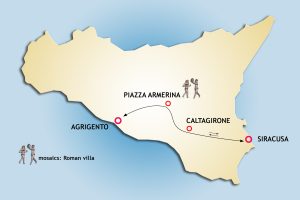 The sixth day departure for Piazza Armerina situated deep in the Sicilian hinterland, at 721 metres above sea level, one of Sicily’s most frequented tourist spots. However, it is not the town that most people come to see, but the famous Villa Romana del Casale. Built in the middle of the 4th Century AD as a hunting lodge by a Roman patrician (it is not known for sure who the owner was) the Villa is home to some of the best preserved and extensive examples of Roman mosaics spread over around 3500mt. This afternoon departure for Caltagirone. Caltagirone is well known for its ceramic art and Sicilians refer to the “Caltagirone style” in ceramic pottery, characterized by ornate traditional motifs using a limited palette. Later onto Syracusa. Learn More
The sixth day departure for Piazza Armerina situated deep in the Sicilian hinterland, at 721 metres above sea level, one of Sicily’s most frequented tourist spots. However, it is not the town that most people come to see, but the famous Villa Romana del Casale. Built in the middle of the 4th Century AD as a hunting lodge by a Roman patrician (it is not known for sure who the owner was) the Villa is home to some of the best preserved and extensive examples of Roman mosaics spread over around 3500mt. This afternoon departure for Caltagirone. Caltagirone is well known for its ceramic art and Sicilians refer to the “Caltagirone style” in ceramic pottery, characterized by ornate traditional motifs using a limited palette. Later onto Syracusa. Learn More
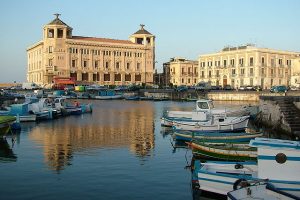 Spend the seventh day in Syracusa and especially in the small Baroque island of Ortigia, the historic center of Syracuse, is widely considered one of the most beautiful destinations in Sicily. Inhabited for over 3,000 years and renowned for its Greek heritage, it is a UNESCO landmark for its “remarkable testimony of the Mediterranean cultures over the centuries” and makes for a perfect long-weekend escape in any season. Start your fourth day in Syracusa to explore the Neapolis Archeological Park of Siracusa. Home to a spectacular 5th century BC Greek Theater – the largest in Sicily – a Roman Amphitheater and the Ear of Dionysus, a large cave with excellent acoustics, it’s worth spending a couple hours marveling at the ancient sites. After you’ve toured the archeological site, head back to into Ortigia to peruse the bustling Ortigia Open Air Market filled with colorful fruit and vegetable stands, fish vendors and stalls selling spices of all types. Be sure to pick up a few local specialties for your pantry, including pistachios from Bronte, almonds from Avola, sun-dried tomatoes from Pachino and capers from Pantelleria. In the afternoon, make your way over to the Dome Square and Fountain of Arethusa before strolling down the Lungomare Alfeo to admire the changing colors in the skyline. Learn More
Spend the seventh day in Syracusa and especially in the small Baroque island of Ortigia, the historic center of Syracuse, is widely considered one of the most beautiful destinations in Sicily. Inhabited for over 3,000 years and renowned for its Greek heritage, it is a UNESCO landmark for its “remarkable testimony of the Mediterranean cultures over the centuries” and makes for a perfect long-weekend escape in any season. Start your fourth day in Syracusa to explore the Neapolis Archeological Park of Siracusa. Home to a spectacular 5th century BC Greek Theater – the largest in Sicily – a Roman Amphitheater and the Ear of Dionysus, a large cave with excellent acoustics, it’s worth spending a couple hours marveling at the ancient sites. After you’ve toured the archeological site, head back to into Ortigia to peruse the bustling Ortigia Open Air Market filled with colorful fruit and vegetable stands, fish vendors and stalls selling spices of all types. Be sure to pick up a few local specialties for your pantry, including pistachios from Bronte, almonds from Avola, sun-dried tomatoes from Pachino and capers from Pantelleria. In the afternoon, make your way over to the Dome Square and Fountain of Arethusa before strolling down the Lungomare Alfeo to admire the changing colors in the skyline. Learn More
Explore Sicily in 8 days
On this eight-day itinerary, you’ll uncover layers of history in the island of Sicily. Is a sort of showcase where you can immerse your senses in the art, culture and gastronomy!
Tour of Sicily has announced a new White Lotus tour that takes guests to many of the real-life settings from the award-winning comedy’s Season 2, set in Sicily.
The White Lotus is an American black comedy-drama anthology television series created by Mike White for HBO. It follows the guests and employees of the fictional White Lotus resort chain whose stay is affected by their various psychosocial dysfunctions.
The first season is set in Hawaii and the second season is set in Sicily.
We are an inbound tour operator specialized in delivering one-of-a-kind holidays around the island committed to make you experience customized tours, food journeys and wine tastings in some of Sicily’s nicest places.
We simply can’t imagine a better way to immerse yourself in the life of Sicily without a company like us, to explore hidden corners and appreciate nuances while enjoying the benefits and enormous satisfaction of traveling under your own power.
Highlights
1st day – Arrival in Palermo airport – Transfer to Palermo
2nd day – Palermo Half Day Walking Tour with Arancine and Street Food tastings
3th day – Cefalù and Monreale
4th day – Palermo to Siracusa (with stops to Agrigento and Piazza Armerina)
5th day – Syracusa, Ortigia and Noto
6th day – Siracusa to Taormina (with stop to the Etna Volcano) with lunch in winery
7th day – Taormina and Godfather Villages
8th day – Departure from Catania airport – Transfer from Taormina
The eight-day-trip begins on the 2nd day with an Half Day Walking Tour with Arancine and Street Food tastings
Today we start with a walk into a lively open-air market, a place with strong Arab influences, resembling a souk, with picturesque stands of fresh fish, cheese, fruit and vegetables. During the tour you will have the opportunity to observe local people in their daily activities and to savor foods that real Sicilian people love to eat! A small tasting of typical street food is included, and we cannot skip the famous Arancine, a delicious, crispy, deep fried Sicilian balls of rice. They have a meat sauce and mozzarella cheese filling and crunchy breadcrumb coating.
The walking tour through the ancient center of Palermo is approx. 2,5 hours and you will visit several monuments including Piazza Pretoria, and the exterior of Cathedral.
The tour will finish at the Four Corner to permit to have the afternoon at leisure to explore Palermo on your own. Read More>
Later we return to Palermo.. Read More>
Today we drive through the interior of Sicily to reach Agrigento to see the Valley of the Temples: two hours guided walking tour on the Valley of the Temples an important Unesco World Heritage site covers the Temple of Hera, the Temple of Concordia, the Temple of Hercules and the Temple of Zeus. Agrigento, according to legend, was founded by Daedalus and his son Icarus after they had fled from Crete “by air”. Historically, however, its origins date back to 582 B.C. when it was founded by Rhodian-Cretan colonist from the neighboring Gela who named their city Akragas after the nearby river. It rapidly increased in size, importance and military strength under Phalarides, the first tyrant, and later under Theron, who extended his way over northern Sicily as far as Himera.
This afternoon we then continue onto Piazza Armerina to enjoy the visit of the amazing Mosaics Floor at the Roman Villa of Casale, that belongs to the Unesco Heritage. Built on the 4th century AD, the Villa was later forgotten and only in the 20th century excavations revealed the whole building. It is the supreme example of a luxury Roman villa (about 3500 square meters of floor mosaics) and was probably the residence of a member of the upper class of the Roman Empire. The mosaics discovered here are celebrated among scholars of antiquity. The visit inside the Roman Villa will be done independently. Every room has information boards. Admission fee not included.
Later onto Siracusa. Read More>
Today visit this wonderful town with a professional guide who will lead you to the discovery of the most important beauties as well as the hidden treasures of Siracusa and Ortigia Island.
Transfer by taxi the Archaeological Park that highlights the Greek Theatre, the Roman Amphitheatre and, the Paradise Quarry. After we travel back to the Island of Ortigia by taxi to start the walking tour from the Aretusa Fountain, visit the incredible Dome of Siracusa built on top of a Greek Temple and today incorporated in a beautiful baroque church!!
Continuing the walk, the tour will end at Apollo Temples to permit you to get back independently to your accommodation.
This afternoon meet the driver and transfer to Noto. a wonderful Baroque town, where you will have time to wander and discover one of the most spectacular urban settlements. Situated in the south-eastern corner of Sicily, Noto is famous for its Baroque architecture, and since 2002 it has been part of the UNESCO World Heritage Site ‘Late Baroque Towns of the Val di Noto’. Read More>
Begin the day with a visit to the lava-crusted slopes of Mt. Etna, which dominates the scenery and is the most active volcano in Europe! Ascend via cable car and jeep to reach the altitude of 9,000 feet; step carefully on the varied layers of lava which have solidified over the centuries. Learn about Etna’s impact on the surrounding area and its unique geology.
Lunch in a winery with wine tastings.
FYI: What’s a visit to Sicily without a visit to a local winery? While there are several options to choose from, the characters in “White Lotus” opted for a visit to the Planeta Sciaranuova Winery, located on the northern slope of Mount Etna. Here youcan take a tour of the winery, taste a variety of vintages, and have lunch, all with magnificent views of Mount Etna in the background. Of course, if you have limited budget, we can swap this winery with a different one, good quality as well, but with reasonable costs.
Then we drive on to Taormina.
FYI: Standing in for the White Lotus is the Four Seasons –San Domenico Palace Hotel, 5 star luxury — located in Taormina. The San Domenico Palace Hotel is a converted 14th-century Benedctine convent offers 111 rooms and suites with five-star service and stunning views of the sea and Mount Etna. Every bit as glamorous as it looks in the TV show, the hotel has been playing host to the rich and famous for some 100 years including the likes of J.P Morgan Jr., Oscar Wilde, Ingrid Bergman, Elizabeth Taylor – and, of course, the cast of “White Lotus.” Read More>
Today you will feel the magical, mythical atmosphere of this town that has enchanted visitors from all over the world for years and years. Settled on a hill of the Monte Tauro, Taormina dominates two grand, sweeping bays below and on the southern side. Taormina really seems to be born as a tourist resort since past times, when ancient people like the Sicels, Greeks, Romans, Byzantines, Saracens, Arabs, Normans and Spaniards choose it as their residential site because of its favourable position, mild climate and magic atmosphere. Guided visit to the ancient Greek Roman Theatre.
FYI: The ancient Greek theater in Taormina serves as a backdrop for an early episode of “White Lotus.” It’s also one of the most popular tourist attractions in Taormina, and the second largest theater of its kind on Sicily. Built during Greek times, but reconstructed by the Romans, the Theater can be visited all year long, but comes to life in the summer when it’s used for outdoor plays, concerts, operas and ballets.
This afternoon we enjoy the scenes of The Godfather movie. From the coastal road, rich of villas, flowering gardens, and picturesque villages, leads to the historical artist town of Savoca. In a private house in the village Bar Vitelli houses a collection of local artisans’ tools and photographs taken when Francis Ford Coppola shot scenes of The Godfather II. Stroll along the village’s main street past Santa Lucia and San Michele churches for a short view over the valley. Read More>
TOP 4 Private Tours
Gold Tour – Private Tour of Sicily
Agrigento, Erice, Etna, Marsala, Modica, Monreale, Palermo, Ragusa, Siracusa, Taormina, Turkish Steps - RealmonteGold Tour - Private Tour of Sicily: an amazing way to visit the island of Sicily in 8 days.8 Days7 Nights- Multidays
- Private Tour
- All Year
Start fromSicilian Experience – Private Tour of Sicily
Agrigento, Cefalù, Erice, Etna, Marsala, Modica, Monreale, Palermo, Piazza Armerina, Ragusa, Siracusa, TaorminaSicilian Exerience: Private Tour of Sicily: an amazing way to visit the island of Sicily in 10 days.10 Days9 Nights- Multidays
- Private Tour
- All Year
Start fromSicilian Highlights – Private Tour of Sicily
Agrigento, Etna, Palermo, Piazza Armerina, TaorminaSicilian Highlights - Private Tour of Sicily: an amazing way to visit the island of Sicily in 7 days.7 Days6 Nights- Multi Days
- Private Tour
- All Year
Start fromThe Peoples of Sicily – Private Tour of Sicily
Agrigento, Erice, Etna, Marsala, Marzamemi, Mazara del Vallo, Modica, Monreale, Mozia island - San Pantaleo, Noto, Palermo, Piazza Armerina, Ragusa, Salt Way Road, Segesta, Selinunte, Siracusa, TaorminaThe Peoples of Sicily - Private Tour of Sicily: an amazing way to visit the island of Sicily in 11 days.
11 Days10 Nights- Multidays
- Private Tour
- All Year
Start from

